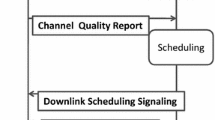Abstract
Carrier aggregation (CA) is introduced in long term evolution advanced (LTE-A) networks for effectively utilize the wider bandwidth of up to 100 MHz, while ensuring the backward compatibility with LTE networks. So, a well-designed scheduling method is indispensable when both the type of users (LTE and LTE-A users) is present in the network. In this paper, a two level calendar disc scheduling method is proposed to satisfy the quality of service requirements of real-time users. A calendar disc is a continuous time frame of one component carrier. Initially, the level-1 scheduler, namely, the disc scheduler (DS) schedules the packets based on user type, packet type and the supported CA by the user equipment by calculating the DS metric and creates calendar discs. At the next level, level-2 scheduler called super scheduler schedules the packets in frequency domain by processing on those calendar disc created by DS. From the simulation results it is confirmed that the algorithm provides 7% increase in Total Goodput, 50% reduction in PLR, 16% reduction in delay for VoIP flows and 5% increase in Total Goodput, 88% reduction in delay for video flows when compared to the existing algorithm.










Similar content being viewed by others
References
GPP TR 36.913 V9.0.0. Requirement for further advancements for E-UTRA (LTE- Advanced, Dec 2009.
GPP, Tech. Specific. Group Radio Access Network- Requirements for Evolved UTRA (E-UTRA) and Evolved UTRAN (E-UTRAN), 3GPP TS 25.913.
Yuan, G. X., Zhang, X., & Wang, W. B. (2010). Carrier aggregation for LTE advanced mobiless communication systems. IEEE Communications Magazine, 48(2), 88–93.
Akyildiz, Ian F., Gutierrez-Estevez, David M., & Reyes, Elias Chavarria. (2010). The evolution to 4G cellular systems: LTE-advanced. Physical Communications, 3(4), 217–244.
GPP TR 36.814: Further advancements for E-UTRA physical layer aspects (Release 9), Jan 2009.
Capozzi, F., Piro, G., Grieco, L. A., Boggia, G., & Camarda, P. (2013). Downlink packet scheduling in LTE cellular networks: Key design issues and a survey. IEEE Communications Surveys and Tutorials, 15(2), 678–700.
Sadiq, B., Baek, S. J., & de Veciana, G. (2011). Delay-optimal opportunistic scheduling and approximations: The log rule. IEEE Transactions on Networking, 19(2), 406–418.
Song, Jungsup, Gil, Gye-Tae, & Kim, Dong-Hoi. (2010). Packet-scheduling algorithm by the ratio of transmit power to the transmission bits in 3GPP LTE downlink. EURASIP Journal on Wireless Communications and Networking, 1(1), 1–8.
Sadiq, B., Madan, R., & Sampath, A. (2009). Downlink scheduling for multiclass traffic in LTE. EURASIP Journal of Wireless Communication Networks, 2(1), 9–13.
Ramli, H., Basukalass, R., Sandrasegaran, K., & Patachaianand, R. (2009). Performance of well known packet scheduling algorithms in the downlink 3GPP LTE system. IEEE International Conference on Communication, MICC, Kuala Lumpur, Malaysia, 1(1), 815–820.
Lai, W. K., Tang, C.-L., & Wei Kuang Lai and Chang-Lung Tang. (2013). QoS-aware downlink packet scheduling for LTE networks. Computer Networks, 57(1), 1689–1698.
Michael Brehm and Ravi Prakash. (2013). Overload-state downlink resource allocation in LTE MAC Layer. Wireless Networks, 19(1), 913–931.
Bokhari, F. A., komeroglu, H., Wong, H. Y., & Rahman, M. (2009). Cross-layer resource scheduling for video traffic in the downlink of OFDMA-based wireless 4G networks. EURASIP Journal on Wireless Communications and Networking, 2009, 1–10.
SajidMushtaq, M., Fowler, S., Mellouk, A., & Augustin, B. (2015). QoE/QoS-aware LTE downlink scheduler for VoIP with power saving. Journal of Network and Computer Applications, 51(1), 29–46.
Rejeba, Sonia Ben, & Nasserb, N. (2014). A novel resource allocation scheme for LTE network in the presence of mobility. Journal of Network and Computer Applications, 46(1), 352–361.
Ivesic, K., Skorin-Kapov, L., & Matijasevic, M. (2014). Cross-layer QoE-driven admission control and resource allocation for adaptive multimedia services in LTE. Journal of Network and Computer Application, 46(1), 336–351.
Sulthana, S. F., & Nakkeeran, R. (2015). Performance analysis of service based scheduler in LTE OFDMA system. Wireless Personal Communications, 83(2), 841–854.
FouziyaSulthana, S. F., & Nakkeeran, R. (2014). Study of downlink scheduling algorithms in LTE networks. Journal of Networks, 9(12), 3381–3391.
Lin, Le-Xiang, Liu, Yuan-an, Liu, Fang, Xie, Gang, Liu, Kai-min, & Ge, Xin-Yang. (2012). Resource scheduling in downlink LTE advanced systems with carrier aggregation. The Journal of China Universities of Posts and Telecommunications, 19(1), 44–49.
Nguyen, S. C., & Sandrasegaran, K. (2012). Optimized proportional fair algorithm for long term evolution advanced system with multiple component carriers. IET Communications, 6(11), 1579–1586.
Galaviz, Guillermo, Covarrubias, David H., Andrade, Angel G., & Villarreal, Salvador. (2012). A resource block organization strategy for scheduling in carrier aggregated systems. EURASIP Journal on Wireless Communications and Networking, 2012(1), 1–17.
Wang, Yuanye, Pedersen, Klaus I., Sorensen, Troels B., & Mogensen, Preben E. (2010). Carrier load balancing and packet scheduling for multicarrier systems. IEEE Transactions on Wireless Communications, 9(5), 1780–1789.
Chung, Yao-Liang, Jang, Lih-Jong, & Tsai, Zsehong. (2011). An efficient downlink packet scheduling algorithm in LTE advanced systems with carrier aggregation. IEEE Consumer Communication and Networking Conference, 1(1), 632–636.
Cormen, T. H., Leiserson, C. E., Rivest, R. L., & Stein, C. (2009). Introduction to algorithms. Cambridge: MIT Press.
Piro, G. LTE-Sim—the LTE simulator. http://telematics.poliba.it/LTE-Sim.
Piro, G., Grieco, L. A., Boggia, G., Capozzi, F., & Camarda, P. (2010). Simulating LTE cellular systems: An open source framework. IEEE Transactions on Vehicular Technology, 60(2), 498–513.
Robalo, D., Velez, F. J., Paulo, R. R., & Piro, G. (2015). Extending the LTEsim simulator with multiband scheduling algorithms for carrier aggregation in LTE advanced scenarios. IEEE Vehicular Technology Conference, 1(1), 1–6.
Jain, R. K., Chiu, D. M. W., & Hawe, W. R. (1984). A quantitative measure of fairness and discrimination for resource allocation in shared computer system. Digital Equipment Corporation Report, DEC-TR-301.
Author information
Authors and Affiliations
Corresponding author
Rights and permissions
About this article
Cite this article
Shakir, S.S.H., Rajesh, A. Performance Analysis of Two Level Calendar Disc Scheduling in LTE Advanced System with Carrier Aggregation. Wireless Pers Commun 95, 2855–2871 (2017). https://doi.org/10.1007/s11277-017-3967-z
Published:
Issue Date:
DOI: https://doi.org/10.1007/s11277-017-3967-z




